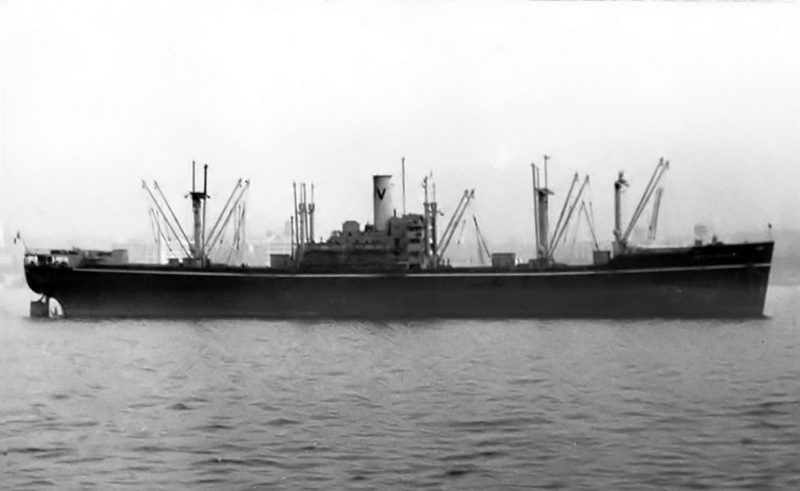
When it comes to assessing a ship’s value, two of my key criteria have always been uniqueness and aesthetics. So it is perhaps unsurprising that the ungainly Montserrat and Begoña, derived from that seemingly limitless supply of wartime Victory freighters, have never exactly set my pulse racing. Such ships rarely seem to warrant or receive special mention in any of the great works of ocean liner history and I’m probably not alone in being rather dismissive of their (Begoña in particular) cumbersome appearance, Spartan accommodation and seemingly dull careers. How wrong I was.
By the time these vessels were acquired by Compañíá Transatlañtica Española (the Spanish Line) they were unrecognisable from the five hold, three mast, one stovepipe funnel ‘Victories’ that had efficiently followed over 500 siblings down the production lines of six US shipyards. Driving each of them to a speed of 17 knots was a single steam turbine generating 6,600SHP comprising a set of High and Low pressure units. Montserrat started life as California Shipbuilding Corporation’s (Calships) yard number V63, a standard VC2-S-AP2 freighter laid down on 9th February 1945 at the company’s Los Angeles yard. Counter intuitively her power plant was built on the opposite side of the country by Allis Chalmers Manufacturing Co. in Milwaukee. Just fifty two days after the keel laying, on 2nd April 1945, she was launched as Wooster Victory (finally a name rather than a number) and before the end of the month was ready to sail on War Shipping Administration duties. The ship had taken a truly astonishing seventy five days from inception to completion. Almost simultaneously on the United States’ Eastern seaboard, another VC2-S-AP2 freighter was taking shape at the Bethlehem Fairfield yard in Baltimore, the ship that would ultimately sail as Begoña. Yard number 2471’s keel was laid on 19th March 1945 and she was launched as Vasser Victory on 3rd May, being completed, with a power plant built by the Westinghouse Electric Company of Pittsburgh on the 28th May, trimming a remarkable five days off her erstwhile sister’s completion time. By then the war in Europe was over and the focus of Allied effort had switched to the Pacific theatre.
In fact this pair ultimately shared the DNA characteristics of just 97 other ‘Victory Ships’, being adapted to carry as many as 1,597 servicemen. Wooster Victory was completed as a troopship in Los Angeles and sent immediately across the Pacific under the management of the General Steamship Corporation, whose funnel colours she bore, arriving in Melbourne on 29th May 1945. It turned out to be the first sector of a veritable maiden world cruise. From Melbourne she sailed to Calcutta, then headed across the Indian Ocean, calling at Lorenzo Marques (Mozambique), Port Elizabeth and Cape Town. From South Africa she sailed direct to Baltimore.
Vasser Victory was somewhat slower joining the fray. She had been assigned to Great Britain in one of the final acts of the Lend-Lease program and after calling at New York was officially handed over to the British exactly one year after D-Day. With the war drawing to its conclusion there was much less urgency surrounding her completion and by the time the conversion was finished the Japanese had surrendered. On 20th September, having been handed back to the American authorities, Vasser Victory departed for the French ports of Seine Est and Le Havre to load her first shipment of demob happy GIs. She would ultimately make eight roundtrips between Europe and the US east coast, two more than Wooster Victory. The latter finished her trooping duties in New York and was initially anchored at Hampton Roads. On 21st August 1946 she joined the James River reserve fleet and was offered for sale. After completing her own repatriation duties at Baltimore on 4th April 1947, Vasser Victory also headed for the James River.
In many ways these first voyages set the tone for the ships’ entire careers. Unglamorous, even austere they may have been, but they fulfilled a hugely important humanitarian role. Whether returning war weary soldiers to their homeland, or stateless refugees and migrants to promised lands, these two ships were a means of fulfilling that first step towards a new and potentially better life. They offered that most valuable of all commodities, hope.
It is now that one of the most illustrious names in shipping enters the story. Alexandre Vlasov was a Cossack of humble origins, who having worked for the Imperial government fled Russia during the post-revolutionary melee. He settled in Romania and progressively developed businesses in coal and shipping. In truth like so many of his generation Vlasov never truly settled, the shifting political landscape forced him to move on, first to Milan in 1938 and then when Italy entered the war in 1940 to Switzerland, New York and ultimately Buenos Aires, taking Argentine citizenship in 1941. Throughout this period Vlasov’s portfolio of shipping companies grew, perhaps most famously with the formation of Società Italiana Transporti Marittimi S.A. (Sitmar) in April 1938.
The end of the war prompted one of the greatest human migrations ever witnessed. Meeting this seemingly insatiable demand tempted several established shipping magnates to take their first steps into the passenger trade. Alexandre Vlasov was one of them.
The problem was finding ships. So much tonnage had been lost during the war and a shortage of raw materials and infrastructure in the cash-strapped 1940s meant building afresh was rarely an option. The availability of cheap replacements became a priority. Fortunately those Liberty and Victory ship production lines had created a glut of superannuated vessels and The Merchant Ship Sales Act of 1946 provided the vehicle by which this redundant stock could be sold to meet demand.
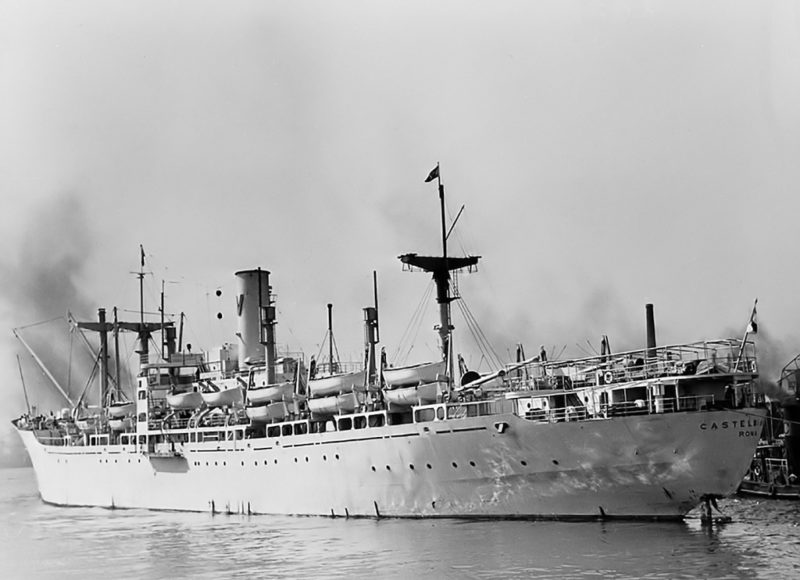
On 21st July 1947 the International Refugee Organisation (I.R.O.) founded its Mass Resettlement Scheme and sought private shipowners capable of meeting the challenge of transporting a multitude of displaced humanity between continents. Vlasov had pre-empted matters by acquiring four Victory ships earlier in the year. Two of these, Lake Charles Victory and Rollins Victory, would be promptly sold on but Wooster Victory and Vassar Victory were retained, the former assigned to Compañía Argentina de Navegación de Ultrmar S.A. (Canumar), the latter to Sitmar.
Vassar Victory was the first to be pressed into service. On 29th May 1947 she left Boston and sailed for Ancona, arriving, after calls at Charleston, Antwerp and Gibraltar, on 19th July where she was promptly renamed Castelbianco and registered in Italy. Although theoretically purchased for the transport of people Castelbianco’s first Sitmar voyage was as a freighter. It was probably just as well. On 16th August 1947 sporting the famous blue V on her otherwise yellow funnel for the first time, Captain Innocente Aschero and his crew set out on one of the longest and most arduous circumnavigations of the modern era. By the time she arrived back in Genoa on 14th October 1948 she had called at twenty three ports including New York, Puerto Belgrano, Sydney, Colombo, Madras and Aden. She had also been involved in two collisions, a grounding and an enforced two month layover at a Sydney shipyard to effect storm damage repairs.
Amidst Castelbianco’s unfolding dramas Wooster Victory was taken from her James River anchorage on 17th February 1948 and proceeded to Baltimore for a refit and reclassification work. The troop accommodation was stripped out and replaced by segregated dormitories for up to 900 men, women and children, together with basic but comfortable dining and recreational facilities. The small central superstructure was extended aft, providing additional public rooms, promenade and sports deck space. She departed New York on 22nd July, loaded cargo at South American ports and then crossed the Atlantic to Genoa.
Whilst being provisioned, Wooster Victory was transferred to a new subsidiary, the Alvion S.S. Corporation. On 6th August she embarked her first passengers, each of whom had paid a nominal £5 for their passage to the Antipodes under the auspices of the I.R.O. The organisation had a doctor, four nurses and an escort officer employed to provide care and information for the Line’s first passenger carrying voyage.
Of course profit was the key driver behind the new venture but it also touched on Vlasov’s altruistic side. Having left home “with only the pockets to put my hands” he felt an affinity with these people and insisted that those first 883 ‘assisted passengers’ (Vlasov employees were banned from using terms like emigrants and displaced persons) be made to feel as welcome and comfortable as possible. After disembarking her passengers in Sydney, like most I.R.O. chartered vessels Wooster Victory returned empty to Europe.
The two ships departed on their second voyages to Australia within a day of each other (18th/19th October 1948). Wooster Victory sailed first with 893 onboard bound for Melbourne, followed by Castelbianco with 879 on a shorter and mercifully less dramatic passage compared to her maiden trip. Nevertheless both would be diverted on their subsequent return to Genoa. On Christmas Eve and New Year’s Eve respectively they called at Shanghai on behalf of the UN, in order to embark refugees, predominantly Jews and White Russians, fleeing the newly installed Maoist regime. Wooster Victory returned to Europe via South Africa where many of her impromptu passengers remained.
Over the course of the next twelve months the ships remained under I.R.O. charter on the Genoa, Melbourne and Sydney service. For the migrants they acted as a portal from the known to the unknown, as part of a much longer and arduous journey. The Sydney Morning Herald reported on 15th March 1949 that Wooster Victory was due in port that day with 890 displaced persons from Baltic countries. They would be taken by special trains to Bathurst and a month’s intensive training in preparation for life in Australia. On two of her six round trips Wooster Victory made detours to Manilla, Shanghai and Cape Town, but otherwise it was a case of sailing south at or near capacity and returning without passengers to Europe. Other than changing their original black hulls for cooler white no modifications were made to the ships, but that would soon change.
On 2nd January 1950 Wooster Victory arrived back at Genoa and moored alongside the Calata San Lazzaro quay for the first of two significant reconstructions. She emerged in mid-May sporting a new, ellipsoidal funnel and additional portholes lining her hull. Internally, new cabins, some benefitting from the light of those portholes, and dormitories were installed, the galley modernised and the superstructure extended to incorporate a larger dining room that doubled as a social hall.
Quite why she had retained her American wartime name until this time remains unclear but when she departed Genoa, full to capacity and dressed overall on Monday 22nd May 1950, it was as Castel Verde. The refurbished and renamed ship was employed on a new South America service and after sailing from Naples bathed in late evening sunlight, she headed out towards the Atlantic, to Las Palmas, Rio de Janeiro, Montevideo and Buenos Aires.
Other than a transfer to SITMAR ownership and Italian registry in September 1950 and the inclusion of additional ports (Palermo, Lisbon, Funchal and Santos) she would maintain this year-round schedule unstintingly for the next three years.
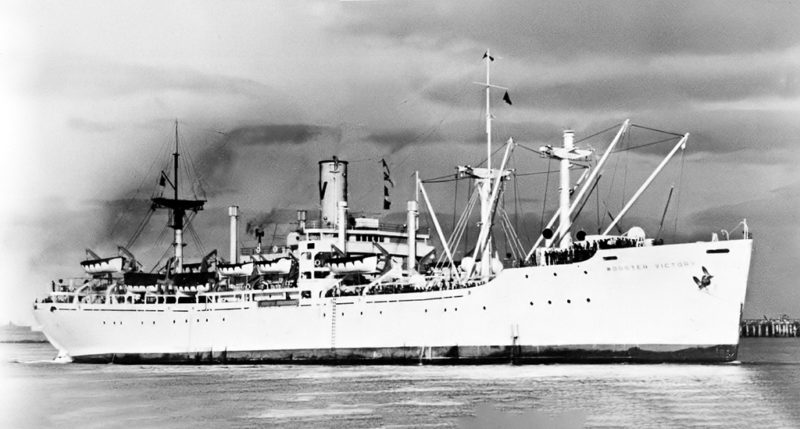
Unlike her fleet mate, Castelbianco remained under I.R.O. charter on the Australia route even after her own significant refit at the same Genoa yard in July 1950. In April her northern terminal port had moved to Bremerhaven and post-refit she would make five round trips annually. She would also make further emergency detours on her homebound voyages. In March and June, pre-refit, and again in October 1950 she deviated to Djakarta as part of a veritable armada that included the famous Oranje, to evacuate Dutch colonials from newly independent Indonesia.
Castelbianco’s rebuild was less obvious than her running mate‘s, primarily because the original funnel was retained. Nevertheless her hull was now repainted white, in keeping with her name, and included additional portholes whilst the superstructure was extended to incorporate a large social hall. The most obvious external change was the profusion of lifeboats, 22 in all now lined her flanks to accommodate the increased complement of 1,132 passengers and 122 crew members. In early September the ship sailed from Bremerhaven for Sydney, and continued that cycle for two years, the only exception being that one detour to Djakarta.
In contrast to the 1950 rebuild, Castelbianco’s 1952 reconstruction was the most dramatic for either ship. On 30th August she entered the Cantieri Riunite dell’Adriatico yard at Monfalcone to be modified according to plans devised by none other than Vladimir Yourkevitch, the famous designer of Normandie, Vlasov’s friend and a fellow Russian émigré. If that French Line masterpiece is often referred to as the most beautiful passenger ship of all time, Castel Bianco, as the Sitmar ship was renamed post-refit, was arguably the antithesis.
Three decks were effectively added to the ship, the full length Saloon Deck with two large dining rooms either end of a central galley was extended in line with the fo’c’sle. Further aft a children’s room and writing room bracketed an elegant Ladies room whose curved walls mirrored the fantail. Open promenades ran around all the new deck housing. One flight up was the newly installed Boat Deck, with eight top grade cabins, some officer quarters, a ballroom, a lounge and farthest aft, a lido and swimming pool. The highest accessible passenger space was on Sun Deck, which as the name suggests offered deck games and sunbathing space forward and aft of more crew quarters. Completing the pyramid was the wheelhouse, one deck higher than its pre-refit position.
Castel Bianco was now 10,139grt and could accommodate 1,194 passengers, 477 in cabins (Boat Deck, Promenade Deck and A Deck) and 717 in twenty four large dormitories down on B deck. Additional portholes were punctured into her flanks. Other than her hull and machinery most remnants of those Victory ship origins were also dispensed with, including the three masts which were replaced by two sets of kingposts and associated booms and the stovepipe stack which gave way to a more modern, sculptured funnel akin to her sister’s. Completing the external transformation was a slender radar mast atop the wheelhouse.
The additional decks and their associated public rooms certainly improved passenger facilities, but compromised the ship‘s stability. From the moment the newly renamed vessel cast off from Genoa’s Ponte dei Mille on 7th March 1953 she gained a reputation as a roller, even in benign seas.
Castel Bianco was transferred to the recently formed Vlasov Central America Line and inaugurated a new service, from Genoa to La Guairá, Venezuala, via Curaçao. It was an instant success, briefly prompting the transfer of the recently refurbished Sitmar flagship Castel Felice and later her erstwhile sister Castel Verde.

The latter continued to ply the South America service until returning from Buenos Aires in April 1953 and entering the Muggiano shipyard at La Spezia on the 25th of the month. Although she had only re-entered service the previous month, Castel Bianco’s stability issues were clearly already evident, because whilst using the same basic blueprints Castel Verde emerged with one deck fewer and a consequentially reduced grt of 9,001.
What would have been Saloon Deck was renamed Boat Deck to reflect the fact that the lifeboats were housed one deck below Castel Bianco’s, and necessarily required some reconfiguration of the cabins and public areas. This resulted in one of the restaurants being housed in the hull on the starboard side of A deck. Total capacity was now 1,033 with 455 in 124 cabins, 39 of which had private bathroom facilities, and 578 in dormitories.
In the short term Castel Verde returned to her previous role with a 2nd June 1953 departure from Genoa to Buenos Aires, although this service was interspersed with round trips to the Antipodes in July 1953 and the following April and June. These Australian voyages were part of a new Sitmar commercial service as opposed to the I.R.O. Arrangement, run in conjunction with Messageries Maritimes and I.M. Skaugen. Following her return from that last voyage on 7th July 1954 she was transferred to the Central America Line sailing from Genoa to Curaçao via Vigo, Lisbon, Madeira and Tenerife and La Guairá, and calling at Tenerife and Barcelona, homeward bound.
Other than two cameo appearances taking Hungarian emigrants from Bremerhaven to Quebec in the Autumn of 1953, in the course of which she was involved in a collision in the St Lawrence which caused minor damage near the stern, Castel Bianco maintained the Central America service undisturbed until December 1956. She was then transferred to a short-lived transatlantic service into New York.
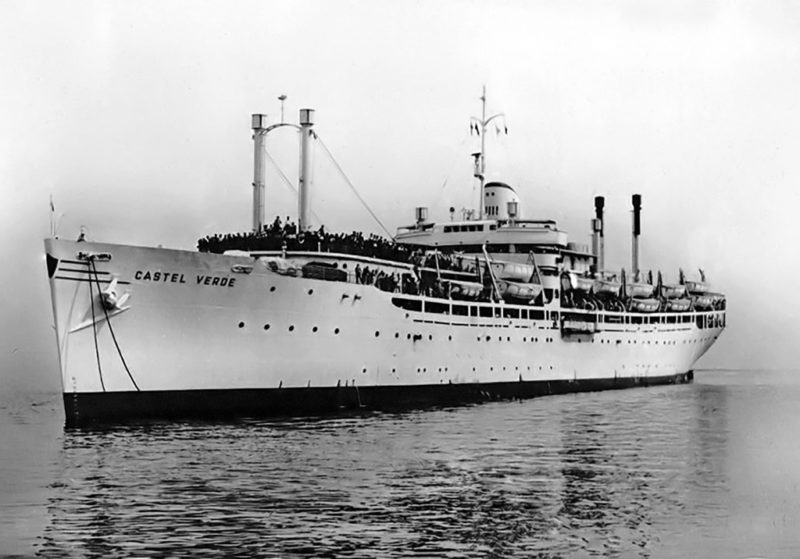
The Central America route thrived. There was a constant stream of Italian and Spanish emigrants, in particular from the Canary Islands embarking at Tenerife, heading for Venezuela and Vlasov signed an agreement with the Jamaican government to sail Eastbound with emigrants bound for Great Britain. Castel Verde and Castel Bianco thereafter incorporated a call at Kingston on their return to Europe. Despite the success Vlasov and Sitmar had their eyes on a greater prize and were investing in new tonnage to support their tender for the Australian assisted passage contract, which was coming up for renewal in 1957. Castel Bianco and Castel Verde no longer featured in their plans.
On 17th February 1956, under the command of Captain Giuseppe Mortola, Castel Bianco arrived back in Genoa following a final twelve day crossing from New York. She was destored, laid up and put on the sales list. A buyer was found almost immediately. On 8th March Spanish Line surveyors and technicians arrived and inspected the ship as she lay in drydock.
Evidently impressed, the company agreed to purchase her, and shortly thereafter, her running mate for a combined $9.5 million. Nine days later and exactly a month after her return to Genoa, she left the Ligurian port for Barcelona under the name Begoña, a municipality, now part of suburban Bilbao, on Spain’s northern shore and a place closely associated with an apparition of the Virgin Mary named Our Lady of Begoña. On arrival at the Catalan port, as well as a mechanical overhaul, the dormitory accommodation was stripped out and replaced by cabins, reducing her overall capacity to 830.
Whilst Begoña was being revamped at Barcelona’s Astilleros Españoles shipyard, Castel Verde was still completing her last scheduled voyage under the Italian flag. She entered Genoa harbour on the evening of 28th March and on 16th April adopted the new name Montserrat, an impressive multi-peaked mountain in Catalonia but like another Spanish Line passenger ship Guadalupe, it also brought to mind a Caribbean island. A week later, after a brief dry-docking in Genoa she joined Begoña in Barcelona for a similar rearrangement of her accommodation.
n May 1957, still sporting a white hull and a yellow funnel, although clearly without the blue Sitmar V, Begoña sailed for Sydney, arriving on 20th June with one of the most unique passenger complements of her long and varied career. It was literally a ‘maiden’ voyage in every sense, since of the over 900 passengers on board only 33 were male. Almost all the rest were single Greek women, referred to as nyfes (brides). When the ship arrived at Melbourne’s Port Philip Bay with several bow plates buckled by the voyage, a crowd of almost 4,000, mainly young Greek men, jammed the pier and every vantage point to see the arrival.
Many of the brides were already betrothed, although this often only consisted of a name and a photograph, but the others were inundated with proposals in the chaotic scenes that followed. A second round voyage to Australia departed from Trieste in August. In contrast to her sister, Montserrat’s first voyage was relatively understated as she essentially continued her Sitmar schedule, plying the mid-Atlantic route from Iberia to Venezuela and the southern Caribbean. Within a year Begoña had joined her.
Both ships soon adopted the Spanish Line’s traditional black funnel and in due course, black hull. The latter did nothing for the ships looks, especially Begoña, and simply accentuated the lofty white superstructure. They also had stovepipes added to their funnels, presumably to carry smuts away from the aft Lido space.
Starting in August 1958 the ships began a new service from a new home port, Southampton. It was the first time Spanish passenger liners had called in Britain since before the war. Sailing out via northern Spain and the Canary Islands to Venezuela and the Dutch Antilles, they now incorporated calls at Port of Spain (Trinidad) and Kingston (Jamaica) to pick up West Indian migrants seeking to settle in the UK.
On occasion other West Indian ports, Grenada and Dominica were included in the itineraries which always called at the Canaries and Vigo on both out and homeward legs. Almost uniquely they were primarily emigrant carriers on both their outbound and homeward voyages. Tourists were later encouraged, whilst reverse migration and journeys back to former homelands supplemented the passenger rosters.
Despite entering service a decade after Empire Windrush’s pioneering voyage, the two Spanish liners garnered plenty of press and public attention when their West Indian passengers came ashore at the alien and frequently frigid Hampshire port. Although advertised as single (Tourist) class ships, immigrants were carried in larger, six to eight berth cabins (Ordinary Tourist) with their own lounge and dining room, whilst Special Tourist offered two to four berth accommodation, many with private facilities and a separate set of public rooms. Of course Tourist Class was really a misnomer since most of the passengers were not Tourists at all.
Interestingly the two ships’ interiors appear to have been quite different. Begoña’s were in general decorated in vibrant colours with contrasting leather upholstery and paintings and murals depicting historical Spanish scenes. Reputedly these were contributed by an artist passenger, which seems rather appropriate. In comparison Montserrat’s interiors appear more conservative, with hardwood furniture and a more neutral colour scheme.
There were more glamorous vessels plying the Atlantic at this time but few could match the Montserrat and Begoña for raw humanity. Formal entertainment was limited, but music, dance and life exuded throughout. The ships were microcosms of the hopes and fears, the eager anticipation tempered with regrets that has always characterised mass migration. Alas testimonials also hint at an unofficial racial segregation, with ‘white’ passengers reputedly receiving preferential cabins and food and even separate meal times in the ship’s dining room. For each individual these were the first steps of a life changing event from which some would prosper but others struggle.
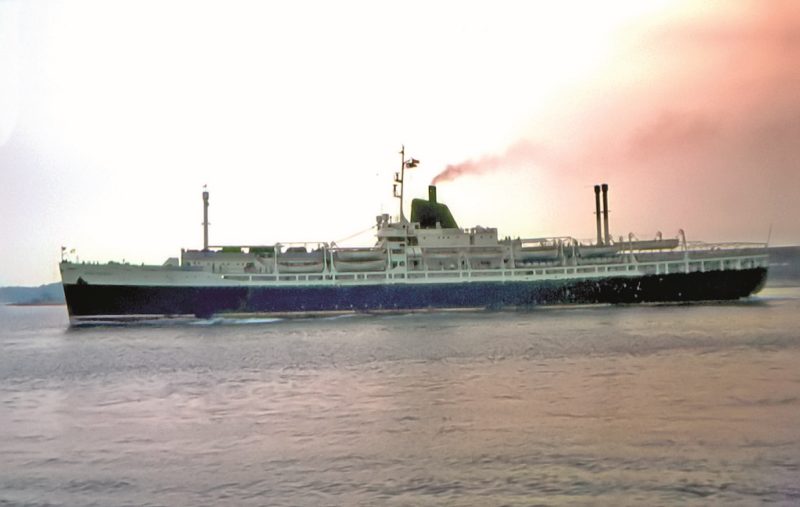
Struggle is certainly an appropriate word for an exceptional voyage made by Montserrat in May/June of 1959 under the command of Captain Raphael Jaume. The ship had been chartered by the Intergovern-mental Committee for European Migration (ICEM) for the transport of Spanish and primarily Greek emigrants to Australia.
In terms of drama it rivalled her sister’s maiden exploits as Castelbianco twelve years previous, except this time passengers were involved. Just hours out of Bilbao one of the 169 all-male Spanish passengers jumped overboard and had to be rescued. At Piraeus she took on about 700 Greek migrants, mainly families and single women. Having passed through the Suez Canal unscathed she developed engine problems after Aden and was adrift in the Indian Ocean before making for Colombo where repairs were effected during a two week layover.
This was not the end of the saga. Two days after departing Ceylon the turbines malfunctioned again and although repaired by the ship’s engineers, a contingent of Greek passengers reputedly stormed the bridge demanding that Captain Jaume return to Colombo for further remedial work. The ‘mutiny’ was quelled by officers wielding batons and rubber hoses and according to one report a warning pistol shot. Montserrat limped on to Fremantle where she arrived on 29th June 1959, three weeks behind schedule. Waiting for her were police and immigration officials as well as a survey team from the Commonwealth Marine Branch. Amongst other failings the latter found that 12 of the ship’s 22 lifeboats were unseaworthy. Captain Jaume was fined £500 for failing to adequately maintain the safety equipment. And the ship prevented from continuing East so passengers either flew or travelled by charter train to their final destinations.
Life onboard became a good deal more comfortable in 1962 when the ships were fitted with full air-conditioning and as the decade progressed the company’s marketing focussed increasingly on the Tourist trade. Prospective passengers were encouraged to “Wine, Dine, Dance, Play and Laze” their way to the sun and the diminutive swimming pool and sports deck became increasingly prominent in the company brochures.
Such honeyed words could not however alleviate the passage of time and in particular the wear and tear on the ships’ hard working machinery. Montserrat was once again left stranded and drifting (this time in the Atlantic) by boiler trouble and then an electrical breakdown in August 1970.
Coincidentally the closest vessel was Begoña which took on her sister’s 675 passengers, resulting in a precarious total of 1,530. After four days adrift Montserrat was finally towed to Willemstad, Curaçao. During the ensuing four months remedial work continued during which her boilers were retubed, accommodation reconfigured and funnel casing heightened. A new look Montserrat emerged in December 1970 sporting a revised company livery, her hull having reverted to white once again whilst her funnel was ochre with a black top and a depiction of the Spanish Line’s company colours, a blue flag with a white central disc. Evidently her owners considered the investment worthwhile, although in truth it was only ever going to be a stop-gap measure.
Of course the 1970s unleashed a perfect storm of events that decimated the traditional liner trade. Jet aircraft stole the passengers as quickly as operating costs, especially fuel and wages, escalated, eroding the last semblance of profitability. Despite her recent refurbishment Montserrat was the first of the pair to go to breakers at Castellon in February 1973. When alternative charter and purchase options failed to materialise the Spanish Line opted to persist with Begoña for two more seasons, but her own dramatic fate wasn’t long in coming.
Variously reported as departing Southampton on 10th or 27th September 1974 (the latter seems most likely) Begoña sailed on what inadvertently became her last commercial voyage. Reports suggest that her Master clairvoyantly refused to take the ship to sea, considering her unsafe. So it was under the command of the Chief Officer that she made a delayed, scheduled stop at Tenerife in early October.
There were already engine problems but despite the concerns of many passengers she departed for Venezuela on 4th October. Once out in mid-Atlantic the engine died. An attempt to restart it reputedly sparked a fire which was quickly extinguished but caused additional damage. Immobilised and impotent with food and water supplies running precariously low, toilets inoperable or overflowing and ventilation having failed in various sections of the ship, conditions became intolerable. She also started to list. An SOS was issued and relayed to the German ocean going tug Oceanic, the largest and most powerful in the world which was then in the Cape Verde islands. After rendezvousing and three days under tow, the pair arrived off Barbados on 17th October and Begoña’s relieved passengers finally made it ashore.
It was self-evidently uneconomic to repair her and she was swiftly sold to the same scrapping firm that had dismantled her sister. Begoña arrived at Castellon on Christmas Eve 1974 just shy of her 30th anniversary. There was of course no grand send-off or nostalgia induced outpouring of emotion at the ships’ passing, few indeed would mourned their loss.

Yet these vessels and their brethren deserve to be honoured way beyond the confines of passenger liner history
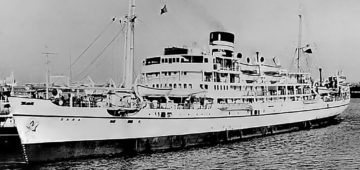



Comments
Sorry, comments are closed for this item